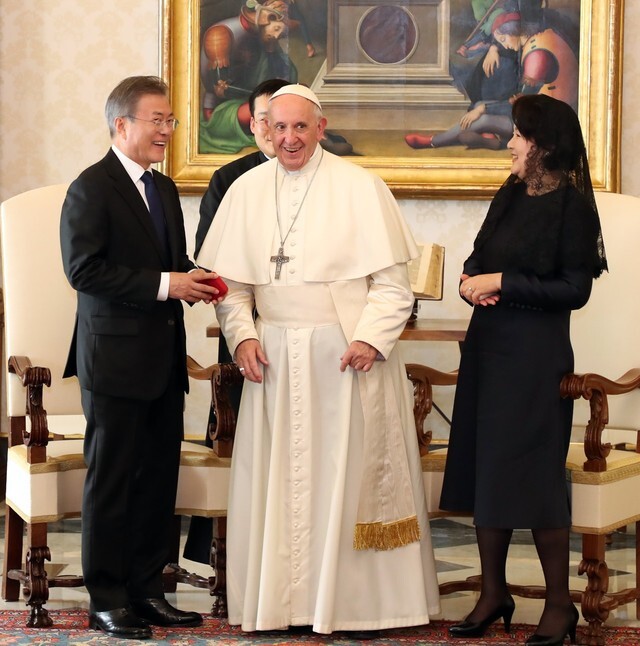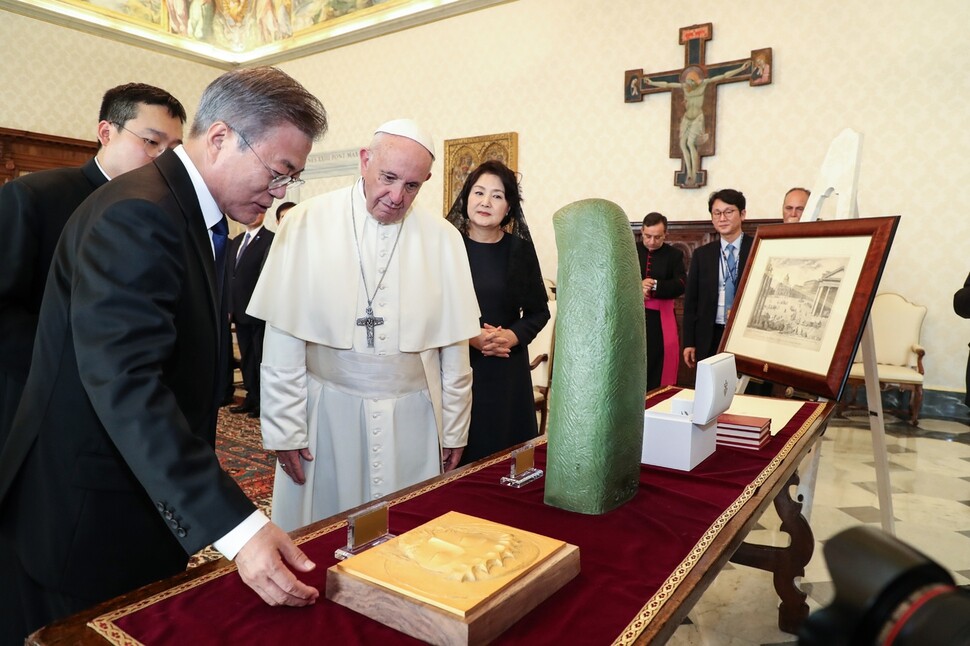hankyoreh
Links to other country sites 다른 나라 사이트 링크
Pope’s visit to North Korea becomes plausible reality

“It’s a pleasure to meet you,” said Korean Christian Federation chairman Kang Myong-chol.
“Peace!” replied Pope Francis, smiling brightly.
The Pope’s meeting with a representative of the North Korean Christian community at a 70th anniversary event for the World Council of Churches (WCC) in Geneva on June 21 was arranged by figures from the South Korean religious community. It was Pope Francis’ first meeting with a North Korean since being named Pope in Mar. 2013.
The idea of the Pope visiting Pyongyang and meeting with North Korea’s 25 million people is no longer just a dream, but something that could soon be a reality. Following his declaration in an Oct. 18 meeting with South Korean President Moon Jae-in that he would “unquestionably answer an [official] invitation” from North Korean leader Kim Jong-un and “could go” to North Korea, the questions of when and how Pope Francis might visit North Korea have become the focus of global attention.
Requirements of canon law for papal visit and their potential burden on N. Korea
But while the Pope’s strong commitment may have been established, many hurdles remain to be cleared for an official visit to take place. According to canon law, a formal invitation must be extended by a country’s government and Catholic church (the diocese leader for the city being visited) for the Pope to visit a specific country. If he does visit, he is to be met by the chairperson of the Catholic Bishops’ Conference of Korea and the bishop of the diocese in the city being visited – an unwritten rule that has established itself as a tradition.
The individual recognized by the Vatican as (acting) bishop of the Pyongyang diocese is Archbishop Andrew Yeom Soo-jung. The administrative requirements would be met with formal invitations from Kim Jong-un and Yeom as acting bishop. Under the current state of affairs, Pope Francis would have to be met by Yeom if he visits Pyongyang.
This would cause a burden for both North Korean authorities and the Vatican. Sources in the religious community said North Korea, with all its emphasis on “autonomy” and “sovereignty,” is unlikely to accept the Pope being met by the South Korean Yeom on behalf of the North Korean Catholic Church – even if the improvement in trust between the two sides after three summits this year is taken into account.
North Korea has around 3,000 registered Catholics, but not a single priest
The Vatican is a similarly awkward spot. North Korea has around 3,000 people registered with authorities as Catholic, but not a single priest. As a sovereign state, the Vatican City focuses on “spreading the gospel” and “guarding world peace and human rights” in its diplomacy. It’s an approach that factors into the Vatican’s lack of diplomatic ties to North Korea or socialist China and Vietnam despite relations with 183 other countries, including South Korea.
In the case of China, which has around 8 million Catholics, the longstanding conflict over the appointment of bishops now stands to be resolved after the two sides signed a preliminary agreement on the matter on Sept. 22. Two Chinese bishops visited the Vatican on Oct. 16 to convey plans to invite the Pope for a visit. This explains the current hopeful predictions that a China visit by Pope Francis may be in the offing. China has not had diplomatic relations with the Vatican since severing them in 1951.
Vietnam’s 6 million Catholics represent the second-highest number in Southeast Asia after the Philippines, and the country has a cardinal appointed by the Pope. Yet the Pope himself has never visited, and diplomatic ties have not been established despite long efforts by the Vietnamese government.

The condition of Catholicism in North Korea is far worse than in either China or Vietnam. Diplomatically, the issue is a thorny one where South Korean Catholicism exercises representation. For this reason, some are predicting that Pope Francis – a self-professed “pilgrim of peace” – is unlikely to pay an official visit to North Korea in the short term.
“It is the clear position of the Holy See Secretariat of State that a visit to Pyongyang by the Pope must be carried out in combination with the promotion of peace on the Korean Peninsula and pastoral aims,” a high-ranking figure in the South Korean Catholic community said. “There are a lot of problems that would need to be solved.”
Because of this situation, staging the visit sooner would require either an exceptional decision by the Pope or some form of workaround.
“The most realistic way of helping the Pope’s Pyongyang visit and meeting with Kim Jong-un happen quickly would be for the Pope to visit South Korea in the near future, using that as an occasion for visiting Pyongyang with representatives of the South Korean religious community,” a high-ranking figure in the religious community said.
“The situation for the North Korean church would have to improve a lot for the Pope to formally visit North Korea, and that’s not something that can be fixed in the short term,” the same figure said. A drawback of the proposed approach is that it would not actually be an official papal visit.
“An official visit by the Pope would be the best way for North Korea to emerge into the international community with its aspirations of being a normal state, and it would be very helpful for peace on the Korean Peninsula,” said Fr. Park Chang-il, who chairs the steering committee of the North Korea assistance group Peace 3000.
“The Vatican and North Korea and South and North Korea need to start now opening everything up to discussions and finding a way,” Park said.
By Lee Je-hun, senior staff writer
Please direct comments or questions to [english@hani.co.kr]

Editorial・opinion
![[Column] Park Geun-hye déjà vu in Yoon Suk-yeol [Column] Park Geun-hye déjà vu in Yoon Suk-yeol](https://flexible.img.hani.co.kr/flexible/normal/500/300/imgdb/original/2024/0424/651713945113788.jpg) [Column] Park Geun-hye déjà vu in Yoon Suk-yeol
[Column] Park Geun-hye déjà vu in Yoon Suk-yeol![[Editorial] New weight of N. Korea’s nuclear threats makes dialogue all the more urgent [Editorial] New weight of N. Korea’s nuclear threats makes dialogue all the more urgent](https://flexible.img.hani.co.kr/flexible/normal/500/300/imgdb/original/2024/0424/7317139454662664.jpg) [Editorial] New weight of N. Korea’s nuclear threats makes dialogue all the more urgent
[Editorial] New weight of N. Korea’s nuclear threats makes dialogue all the more urgent- [Guest essay] The real reason Korea’s new right wants to dub Rhee a founding father
- [Column] ‘Choson’: Is it time we start referring to N. Korea in its own terms?
- [Editorial] Japan’s rewriting of history with Korea has gone too far
- [Column] The president’s questionable capacity for dialogue
- [Column] Are chaebol firms just pizza pies for families to divvy up as they please?
- [Column] Has Korea, too, crossed the Rubicon on China?
- [Correspondent’s column] In Japan’s alliance with US, echoes of its past alliances with UK
- [Editorial] Does Yoon think the Korean public is wrong?
Most viewed articles
- 1[Guest essay] The real reason Korea’s new right wants to dub Rhee a founding father
- 2Why Korea shouldn’t welcome Japan’s newly beefed up defense cooperation with US
- 3[Column] ‘Choson’: Is it time we start referring to N. Korea in its own terms?
- 4New AI-based translation tools make their way into everyday life in Korea
- 5Senior doctors cut hours, prepare to resign as government refuses to scrap medical reform plan
- 6Opposition calls Yoon’s chief of staff appointment a ‘slap in the face’
- 7[Column] Park Geun-hye déjà vu in Yoon Suk-yeol
- 8Terry Anderson, AP reporter who informed world of massacre in Gwangju, dies at 76
- 9N. Korean hackers breached 10 defense contractors in South for months, police say
- 10Will NewJeans end up collateral damage in internal feud at K-pop juggernaut Hybe?